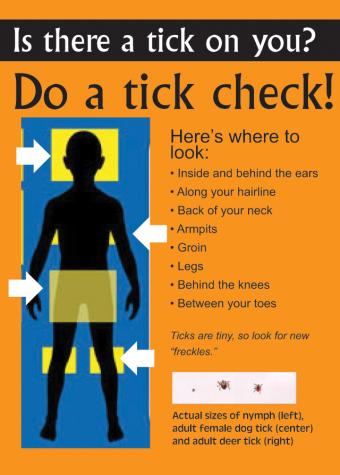Writer
Linda GeistBETHANY, Mo. – Deer hunters may come home with more than trophy antlers this hunting season. Adult deer ticks are most prevalent in the fall as they make a last-ditch effort to find a warm home before winter.
A new University of Missouri Extension guide by extension entomologist Richard Houseman offers suggestions to prevent infestation and check for ticks, which can make their hosts targets for Lyme disease, Rocky Mountain spotted fever and more.
Most ticks are picked up on the lower legs and then crawl upward on the body to settle and feed, said Houseman. The first step in defending against tick bites and tick-borne diseases is to wear clothing that keeps ticks from getting on the skin.
Houseman recommends light-colored clothing, tucking the shirt into the pants and tucking the pants into the socks. Duct taping the bottom of the pant legs closed also prevents ticks from getting to the skin. Some ticks may be small enough to penetrate socks with a coarse weave, and tick repellant is advised.
When returning indoors, check immediately for ticks, which might look like new freckles, says Janet Hackert, MU Extension regional nutrition and health education specialist.
Favorite hiding places include inside and behind ears, along the hairline and on the back of the neck, armpits, groin, legs, behind the knees and between the toes, she said. The Centers for Disease Control and Prevention recommends showering within two hours of coming indoors to reduce the risk of tick bites.
Hackert says ticks should be removed immediately. You can remove ticks with strong tweezers by grasping the tick at the front of the body and as close to the skin as possible. Pull the tick straight out, she said. This allows the natural elasticity of the skin to provide pressure to remove the tick.
Don’t grasp the rear part of the tick’s body, as this can expel the contents of the gut into tissues and increase the likelihood of infection, Hackert said. After removing the tick, clean the bite area and hands with rubbing alcohol, iodine solution or soap and water.
The MU Extension publication “Guide to Ticks and Tick-Borne Diseases” (IPM1032) is available for free download at extension.missouri.edu/publications/ipm1032.
Information also is available from the American Lyme Disease Foundation at aldf.com/#all-about-ticks and from the Centers for Disease Control and Prevention at www.cdc.gov/Lyme.
Hackert can be reached at 660-425-6434 or HackertJ@missouri.edu.
